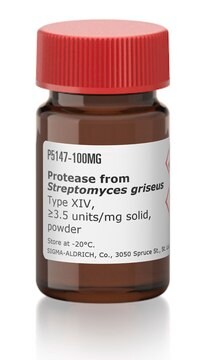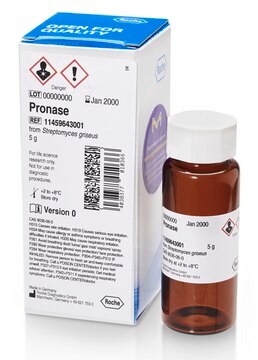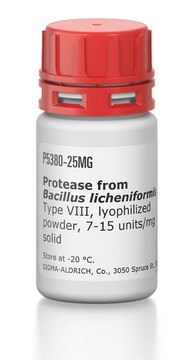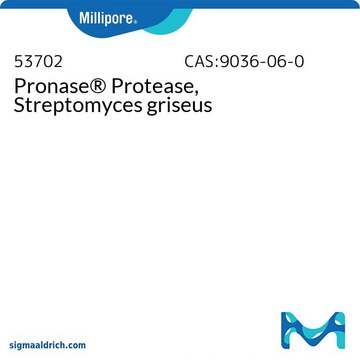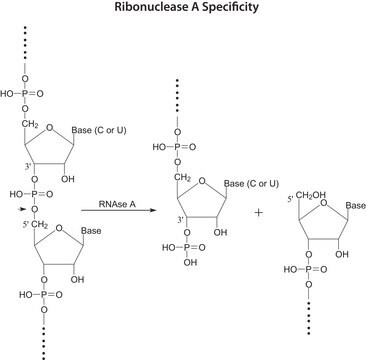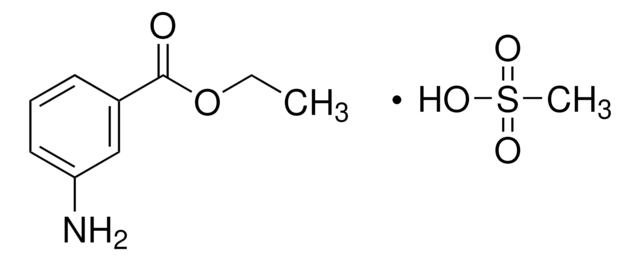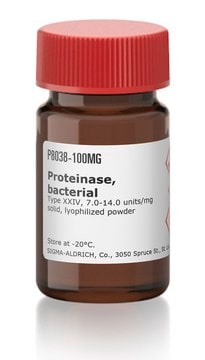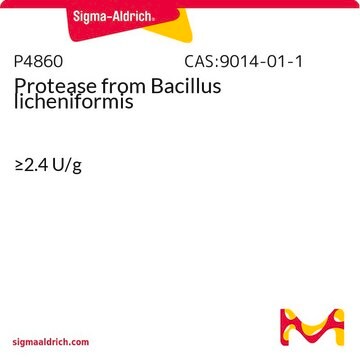P6911
Protease aus Streptomyces griseus
BioReagent, DNase, RNase, and nickase, none detected (No RNase.)
Synonym(e):
Actinase E, Pronase E aus Streptomyces griseus
About This Item
Empfohlene Produkte
Qualität
for molecular biology
Qualitätsniveau
Produktlinie
BioReagent
Form
powder
Mol-Gew.
monomer ~20 kDa
Konzentration
≥4 unit/mg
Löslichkeit
water: 5-20 mg/mL
Fremdaktivität
DNase, RNase, and nickase, none detected (No RNase.)
Lagertemp.
−20°C
Suchen Sie nach ähnlichen Produkten? Aufrufen Leitfaden zum Produktvergleich
Allgemeine Beschreibung
Spezifität
Anwendung
- Nucleic acid isolation procedures in incubations
- Degrade protein during nucleic acid purification
- Proteolysis of insoluble protein
- Structural protein studies
Physikalische Eigenschaften
Einheitendefinition
Angaben zur Herstellung
Hinweis zur Analyse
Sonstige Hinweise
Ähnliches Produkt
Signalwort
Danger
H-Sätze
Gefahreneinstufungen
Eye Irrit. 2 - Resp. Sens. 1 - Skin Irrit. 2 - STOT SE 3
Zielorgane
Respiratory system
Lagerklassenschlüssel
11 - Combustible Solids
WGK
WGK 2
Flammpunkt (°F)
Not applicable
Flammpunkt (°C)
Not applicable
Persönliche Schutzausrüstung
Eyeshields, Gloves, type N95 (US)
Analysenzertifikate (COA)
Suchen Sie nach Analysenzertifikate (COA), indem Sie die Lot-/Chargennummer des Produkts eingeben. Lot- und Chargennummern sind auf dem Produktetikett hinter den Wörtern ‘Lot’ oder ‘Batch’ (Lot oder Charge) zu finden.
Besitzen Sie dieses Produkt bereits?
In der Dokumentenbibliothek finden Sie die Dokumentation zu den Produkten, die Sie kürzlich erworben haben.
Kunden haben sich ebenfalls angesehen
Unser Team von Wissenschaftlern verfügt über Erfahrung in allen Forschungsbereichen einschließlich Life Science, Materialwissenschaften, chemischer Synthese, Chromatographie, Analytik und vielen mehr..
Setzen Sie sich mit dem technischen Dienst in Verbindung.